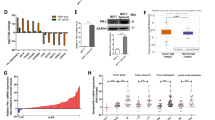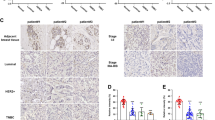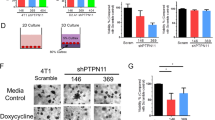Abstract
Most deaths from breast cancer are caused by metastasis, a complex behavior of cancer cells involving migration, invasion, survival and microenvironment manipulation. Type Iγ phosphatidylinositol phosphate kinase (PIPKIγ) regulates focal adhesion assembly and its phosphorylation at Y639 is critical for cell migration induced by EGF. However, the role of this lipid kinase in tumor metastasis remains unclear. Here we report that PIPKIγ is vital for breast cancer metastasis. Y639 of PIPKIγ can be phosphorylated by stimulation of EGF and hepatocyte growth factor (HGF), two promoting factors for breast cancer progression. Histological analysis revealed elevated Y639 phosphorylation of PIPKIγ in invasive ductal carcinoma lesions and suggested a positive correlation with tumor grade. Orthotopically transplanted PIPKIγ-depleted breast cancer cells showed substantially reduced growth and metastasis, as well as suppressed expression of multiple genes related to cell migration and microenvironment manipulation. Re-expression of wild-type PIPKIγ in PIPKIγ-depleted cells restored tumor growth and metastasis, reinforcing the importance of PIPKIγ in breast cancer progression. Y639-to-F or a kinase-dead mutant of PIPKIγ could not recover the diminished metastasis in PIPKIγ-depleted cancer cells, suggesting that Y639 phosphorylation and lipid kinase activity are both required for development of metastasis. Further analysis with in vitro assays indicated that depleting PIPKIγ inhibited cell proliferation, MMP9 secretion and cell migration and invasion, lending molecular mechanisms for the eliminated cancer progression. These results suggest that PIPKIγ, downstream of EGF and/or HGF receptor, participates in breast cancer progression from multiple aspects and deserves further studies to explore its potential as a therapeutic target.
This is a preview of subscription content, access via your institution
Access options
Subscribe to this journal
Receive 50 print issues and online access
$259.00 per year
only $5.18 per issue
Buy this article
- Purchase on Springer Link
- Instant access to full article PDF
Prices may be subject to local taxes which are calculated during checkout







Similar content being viewed by others
References
Jemal A, Clegg LX, Ward E, Ries LA, Wu X, Jamison PM et al. Annual report to the nation on the status of cancer, 1975-2001, with a special feature regarding survival. Cancer 2004; 101: 3–27.
Keshtgar MR, Ell PJ . Sentinel lymph node detection and imaging. Eur J Nucl Med 1999; 26: 57–67.
Stemke-Hale K, Gonzalez-Angulo AM, Lluch A, Neve RM, Kuo WL, Davies M et al. An integrative genomic and proteomic analysis of PIK3CA, PTEN, and AKT mutations in breast cancer. Cancer Res 2008; 68: 6084–6091.
Guertin DA, Sabatini DM . Defining the role of mTOR in cancer. Cancer cell 2007; 12: 9–22.
Ling K, Schill NJ, Wagoner MP, Sun Y, Anderson RA . Movin' on up: the role of PtdIns(4,5)P(2) in cell migration. Trends Cell Biol 2006; 16: 276–284.
Doughman RL, Firestone AJ, Anderson RA . Phosphatidylinositol phosphate kinases put PI4,5P(2) in its place. J Membr Biol 2003; 194: 77–89.
El Sayegh TY, Arora PD, Ling K, Laschinger C, Janmey PA, Anderson RA et al. Phosphatidylinositol-4,5 bisphosphate produced by PIP5KIgamma regulates gelsolin, actin assembly, and adhesion strength of N-cadherin junctions. Mol Biol Cell 2007; 18: 3026–3038.
Ling K, Bairstow SF, Carbonara C, Turbin DA, Huntsman DG, Anderson RA . Type Igamma phosphatidylinositol phosphate kinase modulates adherens junction and E-cadherin trafficking via a direct interaction with mu 1B adaptin. J Cell Biol 2007; 176: 343–353.
Ling K, Doughman RL, Firestone AJ, Bunce MW, Anderson RA . Type I gamma phosphatidylinositol phosphate kinase targets and regulates focal adhesions. Nature 2002; 420: 89–93.
Ling K, Doughman RL, Iyer VV, Firestone AJ, Bairstow SF, Mosher DF et al. Tyrosine phosphorylation of type Igamma phosphatidylinositol phosphate kinase by Src regulates an integrin-talin switch. J Cell Biol 2003; 163: 1339–1349.
Wang YJ, Li WH, Wang J, Xu K, Dong P, Luo X et al. Critical role of PIP5KI{gamma}87 in InsP3-mediated Ca(2+) signaling. J Cell Biol 2004; 167: 1005–1010.
Di Paolo G, Pellegrini L, Letinic K, Cestra G, Zoncu R, Voronov S et al. Recruitment and regulation of phosphatidylinositol phosphate kinase type 1 gamma by the FERM domain of talin. Nature 2002; 420: 85–89.
Liu J, Zuo X, Yue P, Guo W . Phosphatidylinositol 4,5-bisphosphate mediates the targeting of the exocyst to the plasma membrane for exocytosis in mammalian cells. Mol Biol Cell 2007; 18: 4483–4492.
Xiong X, Xu Q, Huang Y, Singh RD, Anderson R, Leof E et al. An association between type Igamma PI4P 5-kinase and Exo70 directs E-cadherin clustering and epithelial polarization. Mol Biol Cell 2012; 23: 87–98.
Wang W, Eddy R, Condeelis J . The cofilin pathway in breast cancer invasion and metastasis. Nat Rev Cancer 2007; 7: 429–440.
Macaluso M, Paggi MG, Giordano A . Genetic and epigenetic alterations as hallmarks of the intricate road to cancer. Oncogene 2003; 22: 6472–6478.
Sun Y, Turbin DA, Ling K, Thapa N, Leung S, Huntsman DG et al. Type I gamma phosphatidylinositol phosphate kinase modulates invasion and proliferation and its expression correlates with poor prognosis in breast cancer. Breast Cancer Res 2010; 12: R6.
De Roock W, Claes B, Bernasconi D, De Schutter J, Biesmans B, Fountzilas G et al. Effects of KRAS, BRAF, NRAS, and PIK3CA mutations on the efficacy of cetuximab plus chemotherapy in chemotherapy-refractory metastatic colorectal cancer: a retrospective consortium analysis. Lancet Oncol 2010; 11: 753–762.
Bertotti A, Migliardi G, Galimi F, Sassi F, Torti D, Isella C et al. A molecularly annotated platform of patient-derived xenografts (‘xenopatients’) identifies HER2 as an effective therapeutic target in cetuximab-resistant colorectal cancer. Cancer Discov 2011; 1: 508–523.
Landi L, Minuti G, D'Incecco A, Cappuzzo F . Targeting c-MET in the battle against advanced nonsmall-cell lung cancer. Curr Opin Oncol 2013; 25: 130–136.
Sun Y, Ling K, Wagoner MP, Anderson RA . Type I gamma phosphatidylinositol phosphate kinase is required for EGF-stimulated directional cell migration. J Cell Biol 2007; 178: 297–308.
Stern DF . Tyrosine kinase signalling in breast cancer: ErbB family receptor tyrosine kinases. Breast Cancer Res 2000; 2: 176–183.
Ponzo MG, Park M . The Met receptor tyrosine kinase and basal breast cancer. Cell Cycle 2010; 9: 1043–1050.
Ghoussoub RA, Dillon DA, D'Aquila T, Rimm EB, Fearon ER, Rimm DL . Expression of c-met is a strong independent prognostic factor in breast carcinoma. Cancer 1998; 82: 1513–1520.
Pulaski BA, Ostrand-Rosenberg S . Mouse 4T1 breast tumor model. Curr Protoc Immunol 2001, Chapter 20 Unit 20 2.
Ishihara H, Shibasaki Y, Kizuki N, Wada T, Yazaki Y, Asano T et al. Type I phosphatidylinositol-4-phosphate 5-kinases. Cloning of the third isoform and deletion/substitution analysis of members of this novel lipid kinase family. J Biol Chem 1998; 273: 8741–8748.
Giudici ML, Emson PC, Irvine RF . A novel neuronal-specific splice variant of Type I phosphatidylinositol 4-phosphate 5-kinase isoform gamma. Biochem J 2004; 379: 489–496.
Giudici ML, Lee K, Lim R, Irvine RF . The intracellular localisation and mobility of Type Igamma phosphatidylinositol 4P 5-kinase splice variants. FEBS Lett 2006; 580: 6933–6937.
Schill NJ, Anderson RA . Two novel phosphatidylinositol-4-phosphate 5-kinase type Igamma splice variants expressed in human cells display distinctive cellular targeting. Biochem J 2009; 422: 473–482.
Radisky ES, Radisky DC . Matrix metalloproteinase-induced epithelial-mesenchymal transition in breast cancer. J Mammary Gland Biol Neoplasia 2010; 15: 201–212.
Chavey C, Bibeau F, Gourgou-Bourgade S, Burlinchon S, Boissiere F, Laune D et al. Oestrogen receptor negative breast cancers exhibit high cytokine content. Breast Cancer Res 2007; 9: R15.
Muller A, Homey B, Soto H, Ge N, Catron D, Buchanan ME et al. Involvement of chemokine receptors in breast cancer metastasis. Nature 2001; 410: 50–56.
Datta D, Flaxenburg JA, Laxmanan S, Geehan C, Grimm M, Waaga-Gasser AM et al. Ras-induced modulation of CXCL10 and its receptor splice variant CXCR3-B in MDA-MB-435 and MCF-7 cells: relevance for the development of human breast cancer. Cancer Res 2006; 66: 9509–9518.
Garofalo C, Koda M, Cascio S, Sulkowska M, Kanczuga-Koda L, Golaszewska J et al. Increased expression of leptin and the leptin receptor as a marker of breast cancer progression: possible role of obesity-related stimuli. Clin Cancer Res 2006; 12: 1447–1453.
Ishikawa M, Kitayama J, Nagawa H . Enhanced expression of leptin and leptin receptor (OB-R) in human breast cancer. Clin Cancer Res 2004; 10: 4325–4331.
Yan D, Avtanski D, Saxena NK, Sharma D . Leptin-induced epithelial-mesenchymal transition in breast cancer cells requires beta-catenin activation via Akt/GSK3- and MTA1/Wnt1 protein-dependent pathways. J Biol Chem 2012; 287: 8598–8612.
Mulligan AM, Raitman I, Feeley L, Pinnaduwage D, Nguyen LT, O'Malley FP et al. Tumoral lymphocytic infiltration and expression of the chemokine CXCL10 in breast cancers from the Ontario Familial Breast Cancer Registry. Clin Cancer Res 2013; 19: 336–346.
Perera CN, Chin HG, Duru N, Camarillo IG . Leptin-regulated gene expression in MCF-7 breast cancer cells: mechanistic insights into leptin-regulated mammary tumor growth and progression. J Endocrinol 2008; 199: 221–233.
McMurtry V, Simeone AM, Nieves-Alicea R, Tari AM . Leptin utilizes Jun N-terminal kinases to stimulate the invasion of MCF-7 breast cancer cells. Clin Exp Metastasis 2009; 26: 197–204.
Gonzalez RR, Cherfils S, Escobar M, Yoo JH, Carino C, Styer AK et al. Leptin signaling promotes the growth of mammary tumors and increases the expression of vascular endothelial growth factor (VEGF) and its receptor type two (VEGF-R2). J Biol Chem 2006; 281: 26320–26328.
Lippitz BE . Cytokine patterns in patients with cancer: a systematic review. Lancet Oncol 2013; 14: e218–e228.
Courtwright A, Siamakpour-Reihani S, Arbiser JL, Banet N, Hilliard E, Fried L et al. Secreted frizzle-related protein 2 stimulates angiogenesis via a calcineurin/NFAT signaling pathway. Cancer Res 2009; 69: 4621–4628.
Bhati R, Patterson C, Livasy CA, Fan C, Ketelsen D, Hu Z et al. Molecular characterization of human breast tumor vascular cells. Am J Pathol 2008; 172: 1381–1390.
De Palma M, Lewis CE . Macrophage regulation of tumor responses to anticancer therapies. Cancer Cell 2013; 23: 277–286.
Weidner N, Semple JP, Welch WR, Folkman J . Tumor angiogenesis and metastasis—correlation in invasive breast carcinoma. N Engl J Med 1991; 324: 1–8.
Thiery JP, Sleeman JP . Complex networks orchestrate epithelial-mesenchymal transitions. Nat Rev Mol Cell Biol 2006; 7: 131–142.
Iwatsuki M, Mimori K, Yokobori T, Ishi H, Beppu T, Nakamori S et al. Epithelial-mesenchymal transition in cancer development and its clinical significance. Cancer Sci 2010; 101: 293–299.
Toker A . Phosphoinositides and signal transduction. Cell Mol Life Sci 2002; 59: 761–779.
Ling K, Schill NJ, Wagoner MP, Sun Y, Anderson RA . Movin' on up: the role of PtdIns(4,5)P(2) in cell migration. Trends Cell Biol 2006; 16: 276–284.
Ali S, Lazennec G . Chemokines: novel targets for breast cancer metastasis. Cancer Metastasis Rev 2007; 26: 401–420.
Li H, Fan X, Houghton J . Tumor microenvironment: the role of the tumor stroma in cancer. J Cell Biochem 2007; 101: 805–815.
Acknowledgements
We thank Dr Daniel Visscher (Mayo Clinic) for scoring the breast cancer tissue microarrays, Dr Wilma Lingle (Mayo Clinic) for providing human breast cancer tissue samples and tissue microarrays, Dr Vijayalakshmi Shridhar (Mayo Clinic) for sharing the 4T1 cells and Dr Kah Whye Peng (Mayo Clinic) for providing the luciferase system. This work was supported by research grants from the National Cancer Institute (1R01CA149039-01A1) and Susan G Komen for the Cure (KG100902).
Author information
Authors and Affiliations
Corresponding author
Ethics declarations
Competing interests
The authors declare no conflict of interest.
Additional information
Supplementary Information accompanies this paper on the Oncogene website
Rights and permissions
About this article
Cite this article
Chen, C., Wang, X., Xiong, X. et al. Targeting type Iγ phosphatidylinositol phosphate kinase inhibits breast cancer metastasis. Oncogene 34, 4635–4646 (2015). https://doi.org/10.1038/onc.2014.393
Received:
Revised:
Accepted:
Published:
Issue Date:
DOI: https://doi.org/10.1038/onc.2014.393
This article is cited by
-
Identification of Bone Metastatic and Prognostic Alternative Splicing Signatures in Prostate Adenocarcinoma
Biochemical Genetics (2023)
-
Interplay between integrins and PI4P5K Sktl is crucial for cell polarization and reepithelialisation during Drosophila wound healing
Scientific Reports (2019)
-
Smurf1 regulates lung cancer cell growth and migration through interaction with and ubiquitination of PIPKIγ
Oncogene (2017)



